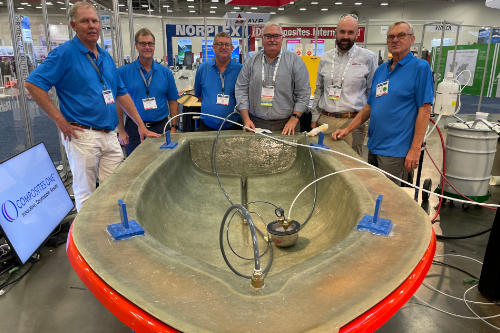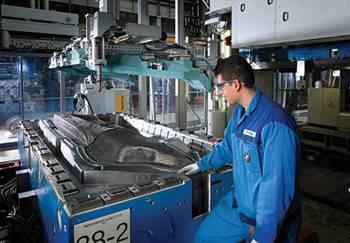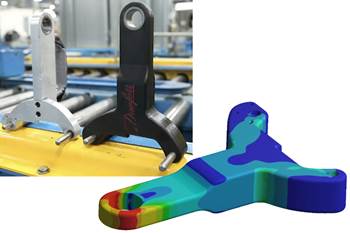Additive Manufacturing/ 3D Printing Using Composites
Additive manufacturing, commonly known as 3D printing, has revolutionized composite production by enabling the layer-by-layer construction of intricate composite structures. In the realm of composites, additive manufacturing techniques allow for the creation of complex geometries with precise fiber orientations and resin distribution, optimizing material performance. This technology offers the flexibility to customize parts, reduce waste, and experiment with novel composite combinations. By depositing materials layer upon layer, additive manufacturing facilitates the production of lightweight, high-strength components tailored for specific applications in industries such as aerospace, automotive, and healthcare, pushing the boundaries of what's achievable in composite design and fabrication.

ESSENTIAL READING
VIEW ALLMaterials & Processes: Fabrication methods
There are numerous methods for fabricating composite components. Selection of a method for a particular part, therefore, will depend on the materials, the part design and end-use or application. Here's a guide to selection.
Read MoreHow to validate 3D-printed composite part performance
Integrated Computational Materials Engineering (ICME) workflow simulates composite material performance to speed development, optimize performance and reduce costs for a redesigned 3D-printed CFRP bracket.
Read MoreContactless measurement of temperature, pressure in composites
Magnetic microwires enable contactless measurement of temperature and pressure during cure and in service.
WatchKnowledge Centers

Join us for insights into advanced bonding techniques and welding processes for composite materials to ensure durability and structural integrity.
LEARN MORE
Closed mold processes offer many advantages over open molding. This knowledge center details the basics of closed mold methods and the products and tools essential to producing a part correctly.
LEARN MORELatest Additive Manufacturing News And Updates
Asahi Kasei, Aquafil develop 3D printing material combining cellulose nanofiber, recycled PA6
Available as a pellet or filament, the material is said to exhibit formability and strength properties suitable for automotive and aerospace applications.
Read MorePurdue researchers create single-photon method for large-scale laser-based 3D additive nanoprinting
Patent-pending technology produces high-resolution nanostructures faster and less expensively than traditional laser nanoprinting.
Read MoreJuggerbot 3D announces MSU, ORNL as partners for hybrid LFAM composites project
Air Force-funded initiative looks to LFAM thermoset, thermoplastic advancement for fast, inexpensive composite tooling production.
Read MoreAIM3D announces Voxelfill resolves inhomogeneous strength of 3D printing
Validation of 80-100% tensile strength and comparability to injection molding via Voxelfill extrusion process was achieved through plastic and fiber-filled test series.
Read MoreOrbital Composites wins AFWERX award for Starfighter drone fleet
Under the TACFI contract, Orbital is implementing the AMCM process to build 3D printed composite multi-mission UAS aircraft, surpassing $10 million in government awards.
Read MoreMitsui Chemicals, ARRK supply composites for Toyota concept car
Tafnex carbon fiber-reinforced PP and 3D printed components find application in Toyota Fortuner-based car designed by TCD Asia.
Read MoreFeatured Posts
Post Cure: Continuous fiber injection reinforces 3D printed parts
Reinforce3D’s postprocessing technology injects continuous carbon fibers and liquid resin into parts with tubular cavities, enabling reinforcement and integral joining for components like a satellite antenna support.
Read MoreAvoiding pitfalls in the design of LFAM composite components
Recoat temperature, part orientation and bead geometry are some key design variables to consider for a successful and reliable large-format additive manufacturing (LFAM) process.
Read MoreAES explores robot vs. gantry for large-format additive manufacturing
Additive Engineering Solutions, specialist at 3D printing very large parts and tools on gantry machines, now also uses a robot for large-format AM. Here is how the robot compares.
WatchOptimized rib-reinforced hollow composites via printed molds
Addyx topology optimization and water-soluble mandrel enables simultaneous rib and skin layup for one-shot, high-strength, lightweight structures.
Read MoreCombining multifunctional thermoplastic composites, additive manufacturing for next-gen airframe structures
The DOMMINIO project combines AFP with 3D printed gyroid cores, embedded SHM sensors and smart materials for induction-driven disassembly of parts at end of life.
WatchReinforcing hollow, 3D printed parts with continuous fiber composites
Spanish startup Reinforce3D’s continuous fiber injection process (CFIP) involves injection of fibers and liquid resin into hollow parts made from any material. Potential applications include sporting goods, aerospace and automotive components, and more.
WatchFAQ: Additive Manufacturing
What is additive manufacturing in composites?
Additive manufacturing, also known as 3D printing, in composites involves the layer-by-layer deposition of composite materials, such as continuous fibers or chopped fibers within a matrix, to create complex parts or structures.
What types of additive manufacturing methods are used for composites?
Various methods are employed, including Fused Filament Fabrication (FFF), Continuous Fiber 3D Printing (CFF), Binder Jetting, Directed Energy Deposition (DED), and others that selectively deposit materials to build composite parts.
What composite materials can be used in additive manufacturing?
Additive manufacturing processes can work with a range of composite materials, such as carbon fiber-reinforced polymers (CFRPs), glass fiber composites, and even advanced materials like nanocomposites or hybrid composites.
What are the advantages of additive manufacturing in composites?
Benefits include the ability to create complex geometries, lightweight structures, reduced material waste, customization, rapid prototyping, and the integration of functional features within parts.
Are there limitations to additive manufacturing in composites?
Challenges include limitations in scaling for large-scale production, post-processing requirements, ensuring consistent mechanical properties, and the need for advancements in material options.





























.jpg;maxWidth=300;quality=90)
